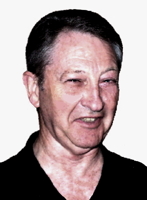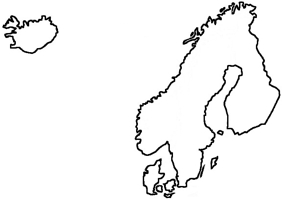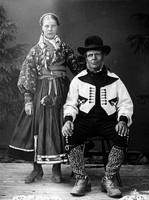
|
The Society of Folk Dance Historians (SFDH)
Choreogeography:
[
Home |
About |
Encyclopedia | CLICK AN IMAGE TO ENLARGE |

|
 Five countries comprise Scandinavia: Norway, Sweden, Finland, Denmark, and Iceland. For the purposes of this study, Norway and Sweden will be observed, because of the fascination with the similarities and differences between them and because of their close proximity. Denmark and Finland are separate and have their own unique, readily recognizable forms, but Norway and Sweden jointly occupy the Scandinavian Peninsula with a common boundary hundreds of miles long.
Five countries comprise Scandinavia: Norway, Sweden, Finland, Denmark, and Iceland. For the purposes of this study, Norway and Sweden will be observed, because of the fascination with the similarities and differences between them and because of their close proximity. Denmark and Finland are separate and have their own unique, readily recognizable forms, but Norway and Sweden jointly occupy the Scandinavian Peninsula with a common boundary hundreds of miles long.
One of folk dance's most thriving groups is the one that thrives on the intricacies and fine points of hundreds of local variations of the dances of Scandinavia. Scandia, as the groups are generally known, has become one of the most sophisticated and knowledgeable disciplines in the folk dance community, one to which many dancers "mature." These clubs exist throughout the country in both recreational dance groups and, happily, many more within the ethnic Scandinavian communities.
Many factors account for the fascination of this dance form, the enchanting fiddle music and the close turning figures being the most obvious.
 To the casual observer – indeed many seasoned observers – the differences between the two are obscure. Norwegians and Swedes have every wish not to be confused with each other; a more-or-less friendly rivalry and slightly veiled contempt for each other comes with the territory. In any event, they are very different from each other and it is only paying each their due to be able to identify their dance and related culture and not casually lump them into one. How to do it?
To the casual observer – indeed many seasoned observers – the differences between the two are obscure. Norwegians and Swedes have every wish not to be confused with each other; a more-or-less friendly rivalry and slightly veiled contempt for each other comes with the territory. In any event, they are very different from each other and it is only paying each their due to be able to identify their dance and related culture and not casually lump them into one. How to do it?
The music gives little clue at first listen. It all sounds alike with fiddles playing a bewildering array of lovely melodies, the first lulling one into a contented dream world, the next blowing wind through deep canyons, yet another as playful and lighthearted as eternal youth.
The dance displays a variety of movement styles; the Scandinavians seem to have invented every possible way for a couple to turn in a dance. Some flow smoothly and effortlessly, while others are full of bounce and energy. Which is which? How to develop a sense of which is Norwegian and which is Swedish?
Help may come in taking a look at the physical topography of the two countries. Though side by side, they do have very different landscapes. Sweden has by far the richer soil and thus more wealth. Her broad countryside lies in gentle, rolling hills heavily cultivated by farmers living in small villages. Norway has the unequalled scenery of rugged mountains, deep fjords and long, narrow glaciated valleys carved deeply into the land, resulting in poorer soils, more restricted overland travel, and a more localized view of the world.
That view of the world is the underlying theory that accounts for the study of Choreogeography. When the people form their culture, they utilize what is available and what feels right and comfortable, what is satisfying and blends with that view. Listen to the music. Listen to the sounds of echoes and rushing water, of wind in the trees and mountains and canyons. Feel the gentle flow of the spirit over a gently rolling landscape, treasured and caressed with the love of generations of people who draw their livelihood from the soil.
Sense the smoothly turning dance of one whose world rises and falls gently for as far as one might travel in a lifetime. Then, feel the bouncy energy of a people who must spend their lifetimes coping with the demands of steep hillsides, yet do it with subdued glee. Take a look at the countless regional variations of the Hambo, yet there is only one Telespringar; danced only in one small valley; the next valley's dance is both different and difficult to reach and likely unknown in Telemark.
Pity those who do not join in the dances of Scandinavia. Their misfortune is to miss out on one of the most satisfying of all dances, created while wrapped in the arms of a strong, sharing partner.
DOCUMENTS
- Richard Duree, an article.
- Scandinavia, a region.
Used with permission of the author.
This page © 2018 by Ron Houston.
Please do not copy any part of this page without including this copyright notice.
Please do not copy small portions out of context.
Please do not copy large portions without permission from Ron Houston.